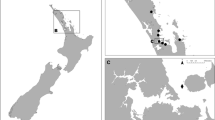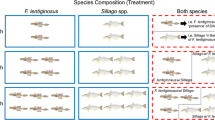Abstract
Populations living in contaminated environments may exhibit behavioral changes that can alter predator–prey interactions. Blue crabs from the contaminated Hackensack Meadowlands (HM) had reduced ability to capture juvenile blue crabs and adult mummichogs (both active prey) compared with crabs from a reference site (Tuckerton (TK)). However, they consumed equivalent amounts of ribbed mussels and fiddler crabs, which are less active prey. Crabs may have reduced coordination rather than appetite or motivation. The lab data are supported by stomach analysis of field-caught crabs. HM crab stomachs contained ∼60% algae, plant material, detritus, and sediment and much lower weights of crab, fish, and other live food than TK crabs. However, the relative absence of bivalves in their diet may reflect reduced amounts available. When TK crabs were caged in HM or fed food from HM in the lab for 8 weeks, their prey capture ability declined significantly, and mercury in their muscle tissue increased significantly, indicating that environmental factors were responsible for the behavioral differences. When HM crabs were caged in TK or fed fish from TK in the lab for 8 weeks, their prey capture ability improved significantly. Mercury levels were variable and did not show a significant decrease.





Similar content being viewed by others
References
Atchison, G.J., M.G. Henry, and M.B. Sandheinrich. 1987. Effects of metals on fish behavior: A review. Environmental Biology of Fishes 18: 11–25. doi:10.1007/BF00002324.
Bertness, M.D., and R. Callaway. 1994. Positive interactions in communities. Trends in Ecological Evolution 9: 191–193. doi:10.1016/0169-5347(94)90088-4.
Boyd, W.A., S.K. Brewer, and P.L. Williams. 2002. Altered behavior of invertebrates in polluted environments. In Behavioral ecotoxicology, ed. Giacomo Dell’OmoWest Sussex: Wiley.
Bragin, A.B., J. Misuik, C.A. Woolcott, K.R. Barrett, and R. Justino-Atresino. 2005. A Fishery Resource Inventory of the Lower Hackensack River Within the Hackensack Meadowlands District: A Comparative Study 2001–2003 vs.1987–1988.
Brousseau, D.J., and J. Baglivo. 2005. Laboratory investigation of food selection by the Asian shore crab Hemigrapsus sanguinaeus: Algal vs. animal preferences. Journal of Crustacean Biology 25: 130–134. doi:10.1651/C-2530.
Brouwer, M., and R.F. Lee. 2007. Responses to toxic chemicals at the molecular, cellular, tissue, and organismal level. In The blue crab, Callinectes sapidus, eds. V.S. Kennedy, and L.E. Cronin, 565–654. College Park, Maryland: Maryland Sea Grant College.
Candelmo, A., A.D. Deshpande, and J.S. Weis. 2007. Trophic transfer and effects on bluefish, Pomatomus saltatrix, consuming contaminated prey. Presented at the 2007. Estuarine Research Federation Meeting. Providence, Rhode Island. Candelmo, A., A. Deshpande, B. Dockum, J. Samson, P. Weis and J.S. Weis. Trophic transfer and effects on bluefish, Pomatomus saltatrix, consuming contaminated prey. In review.
Chapman, P.M., and F. Wang. 2001. Assessing sediment contamination in estuaries. Environmental Toxicology and Chemistry 20: 3–22. doi:10.1897/1551-5028(2001)020<0003:ASCIE>2.0.CO;2.
Clark, M.C., T.G. Wolcott, D.L. Wolcott, and A.H. Hines. 1999. Foraging and agonistic activity co-occur in free-ranging blue crabs (Callinectes sapidus): Observations of animals by ultrasonic telemetry. Journal of Experimental Marine Biology and Ecology 233: 143–160. doi:10.1016/S0022-0981(98)00129-4.
Cruz-Rivera, E., and M.E. Hay. 2000. Can quantity replace quality? Food choice, compensatory feeding, and fitness of marine mesograzers. Ecology 81: 201–219.
Edwards, D.C., D.O. Conover, and F. Sutter III. 1982. Mobile predators and the structure of marine intertidal communities. Ecology 63: 1175–1180. doi:10.2307/1937256.
Elner, R.W., and R.N. Hughes. 1978. Energy maximization in the diet of the shore crab, Carcinus maenas. Journal of Animal Ecology 47: 103–116. doi:10.2307/3925.
Elner, R.W., and R.E. Lavoie. 1983. Predation on American oysters (Crassostrea virginica [Gmelin]) by American lobsters (Homarus americanus Milne-Edwards), rock crabs (Cancer irroratus Say), and mud crabs (Panopeus herbstii [Smith]). Journal of Shellfish Research 3: 129–134.
Engel, D.W., and G.W. Thayer. 1998. Effects of habitat alternation on blue crabs. Journal of Shellfish Research 17: 579–585.
Evans, D.W., R.D. Kathman, and W.W. Walker. 2001. Trophic accumulation and depuration of mercury by blue crabs Callinectes sapidus and pink shrimp Penaeus duorarum. Marine Environmental Research 49: 419–434. doi:10.1016/S0141-1136(99)00083-5.
Fiorenza, M. 1999. Effects of predator foraging behavior on patterns of prey mortality in soft marine bottoms. Ecological Monographs 67: 203–224.
Fleeger, J.W., K.R. Chapman, and R.M. Nisbet. 2004. Indirect effects of contaminants in aquatic ecosystems. The Science of the Total Environment 317: 207–233. doi:10.1016/S0048-9697(03)00141-4.
Hamilton, P.V. 1976. Predation on Littorina irrorata (Mollusca: Gastropoda) by Callinectes sapidus (Crustacea: Portunidae). Bulletin of Marine Science 26: 403–409.
Hebel, D.K., M.B. Jones, and M.H. Depledge. 1997. Responses of crustaceans to contaminants: A holistic approach. Estuarine, Coastal and Shelf Science 44: 1772–1784. doi:10.1006/ecss.1996.0209.
Hines, A.H. 2007. Ecology of juvenile and adult blue crabs. In The blue crab, Callinectes sapidus, eds. V.S. Kennedy, and L.E. Cronin, 565–654. College Park, Maryland: Maryland Sea Grant College.
Hines, A.H., and G.M. Ruiz. 1995. Temporal variation in juvenile blue crab mortality: Nearshore shallows and cannibalism in Chesapeake Bay. Bulletin of Marine Science 57: 884–901.
Hines, A.H., R.N. Lipcius, and A.M. Haddon. 1987. Population dynamics and habitat partitioning by size, sex, and molt stage of blue crabs, Callinectes sapidus, in a subestuary of central Chesapeake Bay. Marine Ecology Progress Series 36: 55–64. doi:10.3354/meps036055.
Hines, A.H., A.M. Haddon, and L.A. Wiechert. 1990. Guild structure and foraging impact of blue crabs and epibenthic fish in a subestuary of Chesapeake Bay. Marine Ecology Progress Series 67: 105–126. doi:10.3354/meps067105.
Hopper, K.R., P.H. Crowley, and D. Kielman. 1996. Density dependence, hatching synchrony, and within-cohort cannibalism in young dragonfly larvae. Ecology 77: 191–200. doi:10.2307/2265668.
Jop, K.M., R.C. Biever, J.R. Hoberg, and S.P. Shepherd. 1997. Analysis of metals in blue crabs, Callinectes sapidus, from two Connecticut estuaries. Bulletin of Environmental Contamination and Toxicology 58: 311–317. doi:10.1007/s001289900336.
Juanes, F. 1992. Why do decapod crustaceans prefer small-sized molluscan prey. Marine Ecology Progress Series 87: 239–249. doi:10.3354/meps087239.
Kennish, M.J., D.J. Danila, and R.E. Hilman. 1982. Assessment of the blue crab, Callinectes sapidus Rathbun, in Barnegat Bay, New Jersey. Bulletin of the New Jersey Academy of Sciences 27: 59–71.
Klerks, P.L., and J.S. Weis. 1987. Genetic adaptation and heavy metals in aquatic organisms: A review. Environmental Pollution 45: 173–205. doi:10.1016/0269-7491(87)90057-1.
Laughlin, R.A. 1982. Feeding habits of the blue crab, Callinectes sapidus Rathbun, in the Apalachicola estuary, Florida. Bulletin of Marine Science 32: 807–822.
Micheli, F. 1995. Behavioral plasticity in prey-size selectivity of the blue crab Callinectes sapidus feeding on bivalve prey. Journal Animal Ecology 64: 63–74. doi:10.2307/5827.
Micheli, F. 1997. Effects of predator foraging behavior on patterns of prey mortality in marine soft bottoms. Ecological Monographs 67: 203–224.
Mosknes, P.-O. 2004. Interference competition for space in nursery habitats: Density-dependent effects on growth and dispersal in juvenile shore crabs, Carcinus maenas. Marine Ecology Progress Series 281: 181–191. doi:10.3354/meps281181.
Nelson, W.G. 1981. Experimental studies of decapod and fish predation on seagrass macrobenthos. Marine Ecology Progress Series 5: 141–149. doi:10.3354/meps005141.
Norse, E.A. 1977. Aspects of the zoogeographic distribution of Callinectes (Brachyuran: Portunidae). Bulletin of Marine Science 27: 440–447.
Peakall, D.B. 1996. Disrupted patterns of behavior in natural populations as an indicator of ecotoxicology. Environmental Health Perspectives 141: 331–335. doi:10.2307/3432653.
Perez, M.H., and W.G. Wallace. 2004. Differences in prey capture in grass shrimp, Palaemonetes pugio, collected along an environmental impact gradient. Archives of Environmental Contamination and Toxicology 46: 81–89. doi:10.1007/s00244-002-0249-9.
Posey, M.H., and A.H. Hines. 1991. Complex predator–prey interactions within an estuarine benthic community. Ecology 72: 2155–2169. doi:10.2307/1941567.
Purdy, J.E. 1989. The effects of brief exposure to aromatic hydrocarbons on feeding and avoidance behavior in coho salmon, Oncorhyncus kitsuch. Journal of Fish Biology 34: 621–629. doi:10.1111/j.1095-8649.1989.tb03340.x.
Santiago Bass, C., S. Bhan, G.M. Smith, and J.S. Weis. 2001. Some factors affecting size distribution and density of grass shrimp (Palaemonetes pugio) populations in two New Jersey estuaries. Hydrobiologia 450: 231–241. doi:10.1023/A:1017505229481.
Silliman, B.R., and M.D. Bertness. 2002. A trophic cascade regulates salt marsh primary production. Proceedings of the National Academy of Sciences USA 99: 10500–10505. doi:10.1073/pnas.162366599.
Smith, G.M., and J.S. Weis. 1997. Predator–prey relationship in mummichogs (Fundulus heteroclitus (L.)): Effects of living in a polluted environment. Journal of Experimental Marine Biology and Ecology 209: 75–87. doi:10.1016/S0022-0981(96)02590-7.
Sponaugle, S., and P. Lawton. 1990. Portunid crab predation on juvenile hard clams: Effects of substrate type and prey density. Marine Ecology Progress Series 67: 43–53. doi:10.3354/meps067043.
Toppin, S.V., M. Heber, J.S. Weis, and P. Weis. 1987. Changes in reproductive biology and life history in Fundulus heteroclitus in a polluted environment. In Pollution physiology of estuarine organisms, eds. W. Vernberg, A. Calabrese, F. Thurberg, and F.J. Vernberg, 171–184. Columbia, SC: University of South Carolina Press.
Virnstein, R.W. 1977. The importance of predation by crabs and fishes on benthic infauna in Chesapeake Bay. Ecology 58: 1199–1271. doi:10.2307/1935076.
Virnstein, R.W. 1979. Predation of estuarine infauna: Response patterns of component species. Estuaries 2: 69–86. doi:10.2307/1351631.
Wallace, W.G., T.M.H. Brouwer, M. Brouwer, and G.R. Lopez. 2000. Alterations in prey capture and induction of metallothioneins in grass shrimp fed cadmium contaminated prey. Environmental Toxicology and Chemistry 249: 183–197.
Weis, J.S. 1976. The effects of mercury, cadmium and lead salts on limb regeneration in the fiddler crab, Uca pugilator. Fishery Bulletin 74: 464–467.
Weis, P., J.S. Weis, and J. Bogden. 1986. Effects of environmental factors on release of mercury from Berry’s Creek sediments and uptake by killifish, Fundulus heteroclitus. Environmental Pollution 40: 303–315. doi:10.1016/0143-1471(86)90064-4.
Weis, J.S., P. Weis, G. Smith, T. Zhou, and C. Santiago-Bass. 2001. Effects of contaminants on behavior: Biochemical mechanisms and ecological consequences. Bioscience 51: 209–217. doi:10.1641/0006-3568(2001)051[0209:EOCOBB]2.0.CO;2.
Werner, E.E., J.F. Gilliam, D.J. Hall, and G.G. Mittelbach. 1983. An experimental test of the effects of predation risk on habitat use in fish. Ecology 64: 1540–1548. doi:10.2307/1937508.
Windham, L., J.S. Weis, and P. Weis. 2004. Metal dynamics of plant litter of Spartina alterniflora and Phragmites australis in metal-contaminated salt marshes. Part 1: Patterns of decomposition and metal uptake. Environmental Toxicology and Chemistry 23: 1520–1528. doi:10.1897/03-284.
Wolcott, D.L., and S. O’Connor. 1992. Herbivory in crabs: A review. American Zoologist 32: 370–381.
Acknowledgments
This project was funded in part by a Rutgers University Marine Field Station Graduate Student Research award and a Meadowlands Environmental Research Institute (MERI) grant. We thank MERI Senior Naturalist B. Bragin, for providing assistance with trawling, Dr. P. Jivoff for providing green crab traps that were used for field-transplanted crabs, Dr. P. Weis for the use of laboratory facilities for Hg analysis, and T. Proctor for assistance with Hg analysis. We also thank Dr. L. Bergey, A. Candelmo, J. Lord, Dr. J. MacDonald, J. Ramirez, S. Shahrestani, and R. Weatherford for field and laboratory assistance. Finally, we thank the anonymous reviewers for the input they have provided, which greatly improved this manuscript.
Author information
Authors and Affiliations
Corresponding author
Rights and permissions
About this article
Cite this article
Reichmuth, J.M., Roudez, R., Glover, T. et al. Differences in Prey Capture Behavior in Populations of Blue Crab (Callinectes sapidus Rathbun) from Contaminated and Clean Estuaries in New Jersey. Estuaries and Coasts 32, 298–308 (2009). https://doi.org/10.1007/s12237-008-9130-z
Received:
Revised:
Accepted:
Published:
Issue Date:
DOI: https://doi.org/10.1007/s12237-008-9130-z




